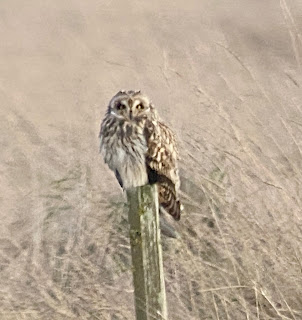28th February. Cloudy, with a strong southerly wind and occasional light showers before heavy rain in the evening. The Kingfisher was mobile between the Mere and Fenland Lagoon. Avocet had increased to 17 on Tennyson's Sands. Southerly migration involved, 60 Lapwing, 60 Starling, 4 Stock Dove, 22 Jackdaw and an alba wagtail down the dunes with 2 Pintail and various waders and gulls offshore. 13 Red-breasted Merganser and 2 Goosander were on the sea. 10 Water Pipit came in to roost. Other notable birds were 2 Stonechat and a Bullfinch around.
Red-breasted Merganser 28th February. Photo: Nige Lound
27th February. A bright morning with strong southerly wind. A few birds moving south down the East Dunes including 10 Jackdaw, 5 Chaffinch, 5 Stock Dove, 2 Great Tit and a Rook. 3 Pintail went south over the sea. 2 Woodlark flew towards North Building Ridge where they may have landed and a Kingfisher was a brief visitor to Shoveler's Pool.
26th February. No records received today.
25th February. A bright, sunny morning with a Westerly breeze becoming stronger. A trickle of visible migration was apparent down the East Dunes early morning including a small number of Chaffinch, Siskin, Goldfinch and Jackdaw south with the first Woodlark of the year. . A Goosander went south down the tideline. It was a great day for birds of prey with the usual Merlin, Peregrine and Hen Harrier, but an influx of Common Buzzard occurred, involving 10 birds, at least 7 of which passed south, including 3 together. 4 Red Kite also passed through; one went high south over the beach at 0820, followed by two together out over Millennium Ridge at 1020 and a later bird at 1530. A short while later, 3 Short-eared owls were hunting the Old Saltmarsh with a Marsh Harrier.
Short-eared Owl 25th February. Photo: Nige Lound
24th February. A calmer morning than of late but with persistent rain from dawn well into the morning. Visibility at sea was reduced but an hours survey prior to 0845 produced 137 Red-throated Diver (99 south), 29 Red-breasted Merganser (10 south) and 180 Eider south. A lone Snow Bunting flew along the beach. A Cetti's warbler was in full song near North Car Park.
23rd February. 180 Brent Geese were on Tennyson's Sands. The Red-breasted Goose having moved down to Wainfleet in recent days. 800 Golden Plover and 300 Pink-footed Geese were disturbed from local fields. 2 Brown Hare were boxing on Croftmarsh.
22nd February. Moderate SW breeze with a dry start to the morning. The highlights of an hour seawatch were a Red-necked Grebe south and a Puffin south with a Guillemot. Various other unidentified Razorbill/Guillemot were seen with typical numbers of Red-throated Diver, Red-breasted Merganser and Eider. A Siskin went south over the East Dunes and another was at the woodland drinking pool. A male Hen Harrier was hunting the Old saltmarsh and a Red Kite passed through.
'Bath-time'. Robin, Blackbird and Chaffinch with Great Tit (above), Siskin and Goldfinch (below). Photos: Adrian Royle
21st February. Moderate to heavy rain with very strong winds again from early on until mid-morning. 2 southbound Goosander and a Goldeneye being the only notable sightings during an early seawatch in atrocious conditions. News from further up the coast indicated a strong Kittiwake movement was underway from early afternoon but coverage was not possible here until between 1630 and 1710. a Total of 260 Kittiwake flew south during that short period, including a single flock of 210 adults, tightly packed and moving slowly south, almost over the beach. 12 Corn Bunting came in to roost in the marsh by the Visitor Centre with a Stonechat nearby and birds of prey were represented by a male Hen Harrier and singe Barn and Short-eared Owl.
Corn Bunting 21st February. Photo: Nige Lound






